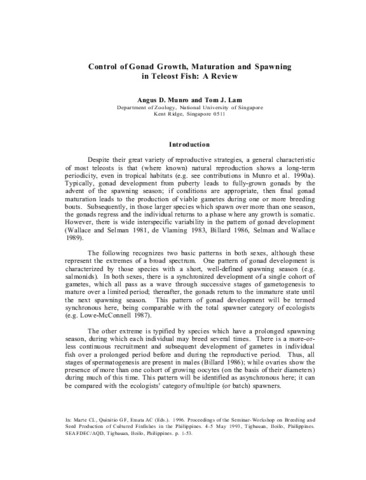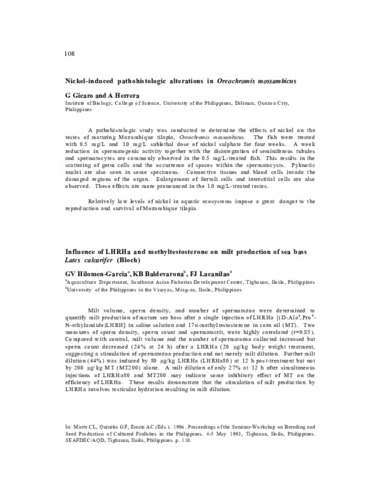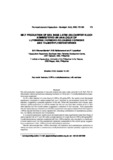| dc.contributor.author | Gallardo, Wenresti G. | |
| dc.contributor.author | Hagiwara, Atsushi | |
| dc.contributor.author | Snell, Terry W. | |
| dc.date.accessioned | 2014-01-07T09:52:13Z | |
| dc.date.available | 2014-01-07T09:52:13Z | |
| dc.date.issued | 2000 | |
| dc.identifier.citation | Gallardo, W. G., Hagiwara, A., & Snell, T. W. (2000). Effect of juvenile hormone and serotonin (5-HT) on mixis induction of the rotifer Brachionus plicatilis Muller. Journal of Experimental Marine Biology and Ecology, 252(1), 97-107. | en |
| dc.identifier.issn | 0022-0981 | |
| dc.identifier.uri | http://hdl.handle.net/10862/1871 | |
| dc.description.abstract | Juvenile hormone (JH) and serotonin (5-HT) were previously shown to enhance mictic (sexual) female production of the rotifer Brachionus plicatilis in batch cultures. To explore the basis of these effects, experiments were conducted on isolated individuals. JH treatment of maternal rotifers with 5 and 50 µg ml-1 (18.8 and 187.7 µM) resulted in significantly higher (P < 0.05) mictic female production in the second (F2) and third (F3) generations. JH treatment was effective even at a lower food concentration of 7 × 105 cells ml, but it was not effective when free ammonia was added at 2.4 and 3.1 µg ml-1. Mictic female production was not increased with exposure to 5-HT up to 50 µg ml-1 (129.1 µM) concentrations. When food level was reduced to 7 × 105 cells ml-1, however, 5-HT-treated rotifers produced significantly (P < 0.05) more mictic females than the control, particularly in F3 generation. Mictic female production of 5-HT-treated rotifers did not differ from that of the control with or without free ammonia, but the intrinsic rate of natural increase (r) of 5-HT-treated rotifers at 3.1 µg ml-1 free ammonia was significantly higher than the control. These results show that juvenile hormone increases mictic female production under optimum and sub-optimum food levels, whereas 5-HT increases both mictic female production at low food level and population growth rate at high free ammonia concentrations. These compounds could be used to manage rotifer cultures and probe the mechanisms controlling the rotifer life cycle as it switches to mictic reproduction. | en |
| dc.description.sponsorship | This study was supported by Grant-in-Aid for Scientific Research from the Ministry of Education, Science and Culture of Japan (No. 10660187) and by a grant from the Ministry of Agriculture, Forestry, and Fisheries of Japan (ED-99-II-3-2). | en |
| dc.language.iso | en | en |
| dc.publisher | Elsevier | en |
| dc.subject | Brachionus plicatilis | en |
| dc.subject | Rotifera | en |
| dc.subject | Mictic female | en |
| dc.subject | juvenile hormones | en |
| dc.subject | 5-Hydroxytryptamine | en |
| dc.subject | Free ammonia | en |
| dc.subject | Food level | en |
| dc.title | Effect of juvenile hormone and serotonin (5-HT) on mixis induction of the rotifer Brachionus plicatilis Muller | en |
| dc.type | Article | en |
| dc.citation.volume | 252 | |
| dc.citation.issue | 1 | |
| dc.citation.spage | 97 | |
| dc.citation.epage | 107 | |
| dc.citation.journalTitle | Journal of Experimental Marine Biology and Ecology | en |
| dc.subject.asfa | ammonia | en |
| dc.subject.asfa | food availability | en |
| dc.subject.asfa | hormones | en |
| dc.subject.asfa | juveniles | en |
| dc.subject.asfa | life cycle | en |
| dc.subject.asfa | reproduction | en |
| dc.subject.asfa | sexual reproduction | en |
| dc.subject.asfa | asexual reproduction | en |
| dc.identifier.doi | 10.1016/S0022-0981(00)00240-9 | |



